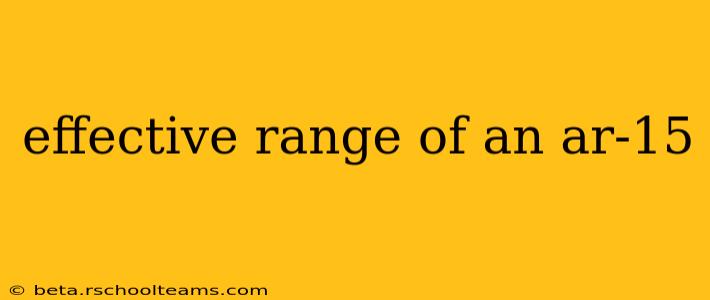Effective Range of an AR-15: Understanding Accuracy and Practical Limits
The AR-15 platform's popularity stems from its versatility and adaptability, but understanding its effective range is crucial for responsible ownership and safe operation. While often marketed as a long-range rifle, the "effective range" isn't a single number but a nuanced concept dependent on several factors. Let's delve into what truly constitutes the AR-15's effective range and what factors influence it.
What is Effective Range?
The effective range of a firearm isn't simply how far the bullet travels before hitting the ground. Instead, it refers to the maximum distance at which a shooter can consistently achieve hits on a target of a specific size, considering factors like accuracy, bullet drop, wind drift, and the shooter's skill. For the AR-15, this is generally considered to be the distance at which a skilled shooter can reliably engage a human-sized target.
Factors Affecting AR-15 Effective Range
Several factors significantly impact the effective range of an AR-15:
- Ammunition: Different ammunition types (e.g., 5.56 NATO, .223 Remington) exhibit varying ballistic characteristics. Heavier bullets generally have less drop and drift over distance, extending the effective range. The quality of the ammunition also plays a crucial role; inconsistent rounds will reduce accuracy.
- Barrel Length: Longer barrels generally improve velocity and accuracy, leading to a longer effective range. Shorter barrels sacrifice some velocity and accuracy at longer ranges.
- Optics: Properly sighted-in optics are essential for accurate shooting at longer distances. A quality scope or red dot sight allows for precise target acquisition and compensation for bullet drop. Magnification also impacts target identification at longer distances.
- Shooter Skill: Marksmanship proficiency is arguably the most critical factor. A skilled shooter can achieve higher accuracy at greater distances than a novice, even with the same equipment. Practice and training are paramount.
- Environmental Conditions: Wind speed and direction significantly affect bullet trajectory. Extreme temperatures can also influence the projectile's performance. Understanding these environmental factors is key to accurate long-range shooting.
Practical Effective Range of an AR-15
Considering these factors, the generally accepted practical effective range of an AR-15 with standard 5.56 NATO ammunition and a 16-inch barrel is between 300-500 yards for a skilled shooter with quality optics. Beyond this range, accuracy diminishes significantly, and the probability of a successful hit decreases considerably. While some specialized AR-15 configurations and ammunition may extend this range slightly, it's important to remember that even with optimal conditions, consistent hits become increasingly difficult beyond 500 yards.
Beyond the Effective Range: Considerations for Responsible Use
It's crucial to understand that firing an AR-15 beyond its effective range is not only less accurate but also potentially dangerous. Beyond 500 yards, bullet trajectory becomes highly unpredictable, increasing the risk of unintended consequences. Responsible gun ownership includes recognizing the limitations of one's firearm and using it appropriately within its effective range.
Conclusion: Know Your Limits
The effective range of an AR-15 is not a fixed number. Understanding the influencing factors and responsible use is paramount for every AR-15 owner. Prioritize training, utilize quality equipment, and always shoot within your known capabilities and the firearm's practical limits. Remember, safe and responsible firearm handling is a continuous learning process.
